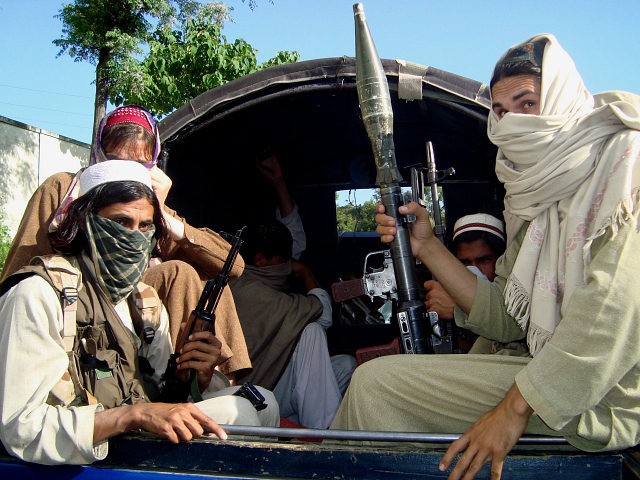Pakistan remained a safe haven last year for Afghan Taliban and Haqqani Network (HQN) jihadis despite the pressure the Trump administration applied on the country to stop harboring terrorist groups, the U.S. State Department reported on Wednesday.
In its Country Reports on Terrorism 2017 released this week, which cover terrorist activities across the world last year, State noted:
The Pakistani government pledged support to political reconciliation between the Afghan government and the Afghan Taliban but did not restrict the Afghan Taliban and HQN from operating in Pakistan-based safe havens and threatening U.S. and Afghan forces in Afghanistan. Pakistan did not take sufficient action against other externally focused groups such as Lashkar e-Tayyiba (LeT) and Jaish-e-Mohammad (JeM) in 2017, which continued to operate, train, organize, and fundraise in Pakistan.
Trump administration officials have described “reconciliation” between the Afghan Taliban and Kabul as the primary goal of the U.S. strategy to end the 17-year-old Afghan war.
In recent months, the U.S. has intensified its efforts to convince the Taliban to engage in peace talks with the Afghan government.
The Pentagon has for years cautioned that Pakistan knowingly serves as a sanctuary for Afghan Taliban and Haqqani terrorists who have killed and maimed U.S. and Afghan troops.
Taliban ally al-Qaeda is also known to operate along the Afghanistan-Pakistan border.
State reported:
Although Pakistan’s National Action Plan calls to “ensure that no armed militias are allowed to function in the country,” several terrorist groups focused on attacks outside of the country continued to operate from Pakistani soil in 2017. These groups included the Haqqani Network, Lashkar e-Tayyiba, and Jaish-e-Mohammad. Pakistan continued military operations to eradicate terrorist safe havens in the Federally Administered Tribal Areas, although their impact on all terrorist groups was uneven.
The Trump administration has suspended hundreds of millions of dollars in security aid to Pakistan over Islamabad’s refusal to take action against the Afghan Taliban and the Haqqani Network. However, every assessment following the administration’s move has determined that Pakistan has failed to take decisive action against the terrorist groups.
The State Department also warned that it is concerned about terrorists smuggling weapons of mass destruction (WMD) across Afghanistan’s porous border with nuclear-armed Pakistan.
State reported:
Terrorist and insurgent groups are active in the border region of Afghanistan and Pakistan. The Government of National Unity (GNU) struggled to assert control over this remote terrain, where the population is largely detached from national institutions … The potential for weapons of mass destruction (WMD) trafficking and proliferation remained a concern … The United States continued to assist the GNU in building capacity to secure potentially dangerous biological materials and infrastructure housed at Afghan facilities, to promote surveillance capabilities to detect and identify possibly catastrophic biological events, and to engage Afghan scientists and engineers that have WMD or WMD-applicable expertise.
State acknowledged that Pakistan is committed to combatting the trafficking of WMDs and any related items.
Moreover, State conceded that Pakistan is actively fighting terrorists who operate on its soil, admitting that some of those groups, namely Tehrik-e-Taliban Pakistan (TTP), used the Afghanistan-Pakistan border region as a sanctuary.
“Terrorist groups targeting Pakistan, such as Tehrik-e-Taliban Pakistan, exploit ungoverned spaces in the Afghanistan-Pakistan border region, using them as safe havens to coordinate terrorist attacks inside Pakistan,” State pointed out.
TTP is a separate entity from the Afghan Taliban.
Both Afghanistan and Pakistan suffered attacks at the hands of the Islamic State (ISIS/ISIL) branch in the region known as the Khorasan Province (ISIS-K).
Echoing the Pentagon, State noted that al-Qaeda continues to operate along the Afghanistan-Pakistan border region.
State reported:
Although al-Qa’ida (AQ) in Afghanistan and Pakistan has been seriously degraded, remnants of AQ’s global leadership, as well as its regional affiliate al-Qa’ida in the Indian Subcontinent (AQIS), continued to operate from remote locations in the region that historically have been exploited as safe havens.
Afghan and Pakistani forces continued to contest AQ’s presence in the region, and Pakistan’s military operations in the Federally Administered Tribal Area (FATA) further degraded the group’s freedom to operate. Pressure on AQ’s traditional safe havens has constrained its leadership’s ability to communicate effectively with affiliate groups outside of South Asia.
State’s report came more than 17 years after the U.S. invaded Afghanistan to eliminate the al-Qaeda and the Taliban.
The report determined that the Taliban is the second deadliest terrorist group in the world, surpassed in lethality only by ISIS. Taliban terrorists carried out 703 attacks last year that killed 3,654 and wounded 3,205.
Meanwhile, State attributed 857 attacks in 2017 that left 4,350 dead and 3,262 others injured to ISIS.

COMMENTS
Please let us know if you're having issues with commenting.